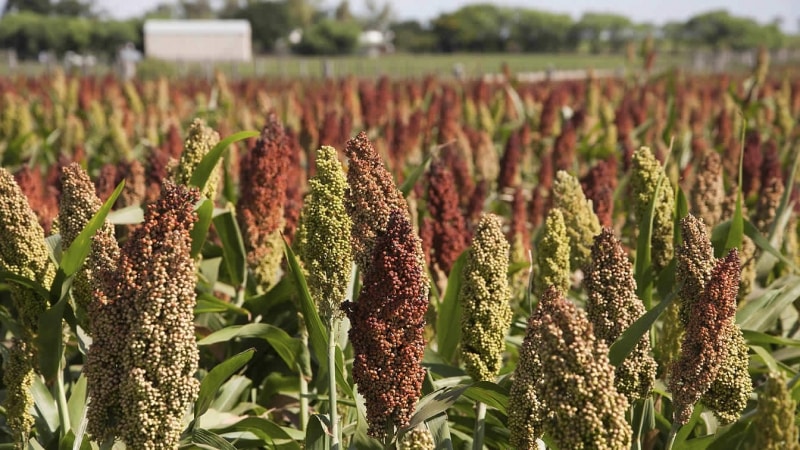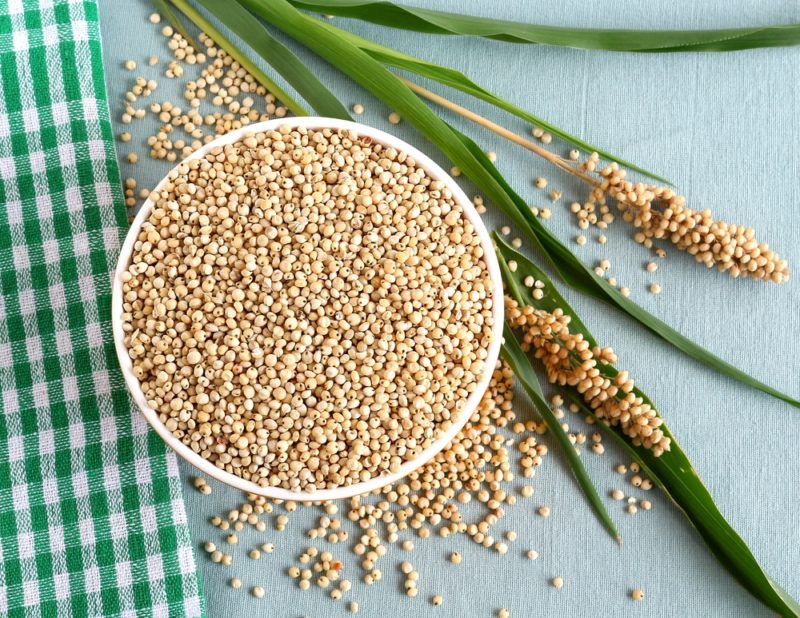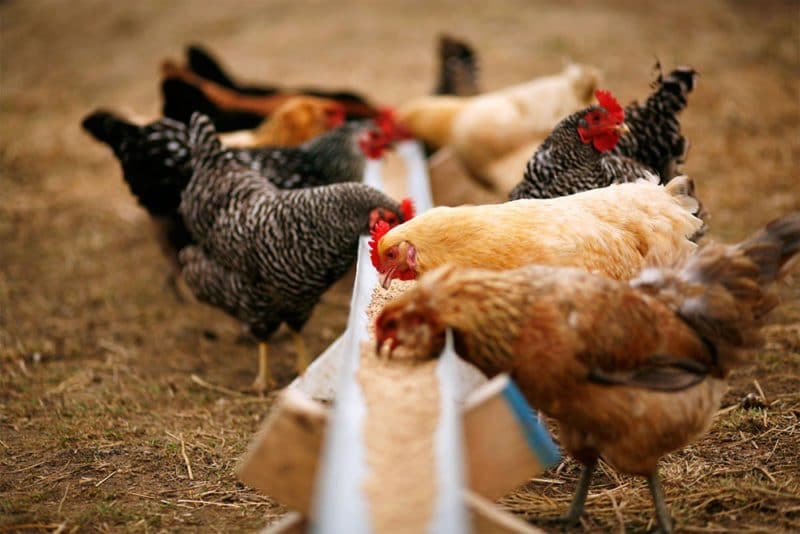Use of sorghum as feed for poultry and livestock
Sorghum is not known to everyone, but it has been used by humans for several thousand years in various industries. The plant is widely used in animal husbandry, medicine and industry. Cereals, flour and starch are obtained from seeds of different colors - from fodder white sorghum to brown and even black.
In many African countries, the crop occupies a leading position among grain plants. Today, sorghum has taken 5th place among grains in the world, behind wheat, rice, corn and barley. We will tell you what it is, how it is used as food for birds and animals, and what benefits it brings.
What is sorghum

This is an ancient forage, food and industrial crop, the homeland of which is considered to be the equatorial regions of Africa. The plant was brought to the territory of the Russian Empire in the 17th century. It is very unpretentious, brings abundant harvests, and with irrigation can produce up to 4 cuttings. Thanks to its developed root system, it adapts well to poor soils, withstands prolonged temperature increases and drought, and is practically not damaged by diseases and pests.
Reference. The crop is capable of falling into suspended animation under unfavorable conditions (heat, drought) and then resuming the growing season. That's why sorghum nicknamed the “camel” of the plant world.
The only drawback is the heat-loving nature. For good growth, sorghum requires temperatures above 15°C; it does not tolerate frost at all.
All modern varieties must meet a number of requirements:
- high and regular yield;
- resistance to diseases, pests and unfavorable climatic factors;
- adaptability to mechanized collection;
- excellent product quality.
There are many types of sorghum used in livestock farming: grain sorghum, sugar sorghum, grass sorghum (sudanese) and broom sorghum. Each has certain advantages and disadvantages.
Food
Cereal has the greatest distribution. primary goal growing - obtaining grain used for flour production, croup, fodder. It is superior in starch content to corn. Sorghum is often used in the preparation of feed for all farm animals and birds.
Food varieties, for example, Kamyshinskoe 75, Kubanskoe Krasnoe 1677, Ukrainskoe 107, are weakly bushy, low - growth ranges from 95 to 125 cm. The panicles are erect, the grains are open, and easily fall off. Productivity reaches 58 c/ha.
Stern

Sudan grass - a valuable fodder crop. Used for preparation, silage, haylage, hay, grazing. One plant can have 5 or more thin succulent stems, the daily growth of which is 10 cm.
After mowing, the plant grows back quickly. It reaches a height of 3 m or more. The yield of green mass is on the same level as corn, 380-500 c/ha. To obtain high quality hay, the grass is mowed before the panicle begins to emerge.
When harvesting during the budding phase, silage with maximum nutritional value is laid, which has a good aroma and taste, making it much better eaten by animals. These include the varieties Dneprovskaya 54, Mironovskaya 10, Donetskaya 5.
Broom sorghum used for weaving brooms, brushes.The by-product - filmy grain - does not collapse well and is used in feeding birds and animals. It is characterized by a dry core of the stem, the panicle is long - 40-90 cm, the main axis is absent.
The plant is 160-180 cm high and does not bush. Grain yield is 15-20 c/ha, broom yield is 2-4 thousand per hectare. The stems are not suitable for food due to the dry core. The varieties Venskor and Zernogradskoe 38 belong to this variety.
Universal
Sweet sorghum occupies an intermediate position between feed and food purposes, and can be used for the preparation of feed for livestock, poultry and technical purposes. The grain yield is 30-38 c/ha, greens - 380-400 c/ha. The grains are membranous or semi-membranous, difficult to shed.
A feature of the species is considered to be increased juiciness and the ability to accumulate a lot of sugars in the juice of the stem. The plant is slightly bushy, with a sugar content of 12% to 20%, so it ensiles well. The optimal time for harvesting for silage is the stage of complete ripeness of the grain; it is at this moment that the highest concentration of sugars is observed.
Plants often have a small panicle and are taller than cereal species. The size ranges from 180 to 220 cm. The varieties Zernogradsky Yantar and Silosnoye 42 are representatives of the sugar species.
Use of sorghum as feed

Initially, the seeds were sown to separate the boundaries of plots and to weave brooms for household needs. Now grain is used to prepare cereals, animal feed, and as a raw material for the alcohol industry. Green mass is used to make silage, haylage, and hay. Even outwardly identical varieties can differ in chemical composition and have different nutritional value.
Reference. The main component in sorghum is protein, the content of which its grains have no equal to among other additives.
When feeding animals and birds, it must be taken into account that colored shells contain the harmful element tannin, which impairs the palatability of the additive, reduces the digestibility of protein and the weight gain of animals by 1.5-2 times.
Thanks to the intensive work of plant breeders, new varieties and hybrids have been obtained with a low tannin content or without them at all. To fully utilize the nutritional potential, the grain must be ground.
The digestibility of sorghum in feed, its energy intensity and starch digestibility depend on crushing.. The finer the grind, the better the grains are absorbed by the animal’s body. The most optimal particle size is 2 mm.
For the bird
Cereals are rarely used to feed poultry today, but they are nutritious foods that are not inferior in calorie content to corn and barley. Due to the physiological characteristics of the stomachs of birds, grain does not need to be crushed or collapsed; they are able to digest it whole.
Sorghum for laying hens

Laying hens need a balanced menu so that they produce not only tasty, but also high-quality eggs. Small farms rarely offer birds feed and similar purchased mash. Usually mixtures of different types are used.
Sorghum, whose grain has almost 10 times the content of calcium, sodium and magnesium compared to other crops, can safely account for up to 50% of a laying hen’s diet. This helps saturate the bird’s body with minerals and the formation of eggshells. Sorghum is given to chickens to increase egg production by 25-30%.
For pigeons
Pigeons need a diet rich in micro- and macroelements, which will form a strong immune system. They, unlike other birds, have a short intestine. Plant fiber is not fully absorbed, so the need for high-quality feed is quite high.
The diet must contain at least 15% protein. Sorghum contains a significant amount of protein and serves as the basis for feed for pigeons. The grains are ground in the small crop of these birds and serve as their favorite delicacy. An adult eats from 30 to 50 g of dry food per day. It is desirable that 20% of this amount be sorghum.
For ducks
Cereal feed is the basis of the caloric nutrition of ducks, and sorghum is readily eaten by them and is well digested. The nutritional value is higher than that of oats. When feeding grains, it is necessary to add supplements that contain protein to the diet. Ducklings 20-25 days old are given ground or crushed sorghum, sifted from the shells. Its volume in the flour mixture can reach 15-25%.
For parrots
Proper nutrition of parrots in captivity is the main factor influencing their health. Sorghum is a type of millet, so parrots enjoy eating it. They prefer small grains with a diameter of 2-3 mm. This should be taken into account when preparing a feed mixture, in which sorghum occupies up to 20%. You can hang whole panicles in cages with birds. They love to select grains from the inflorescences. At the same time, for parrots it is better to use sorghum varieties with a light film.
For pigs
Pigs eat sorghum well; some farms use the crop as the main element of feed. The total percentage in the pig diet should be 30-50. At the same time, rapid growth of piglets, especially late farrowings, is observed.
Reference. Sorghum is used at all stages of pork production: during the reproductive period, during growth and fattening.
Sorghum in feed additives is equivalent to barley grains: pigs provide the same weight gain and quality of meat. It turns out dense, rich pink in color and sells well on the market.
For cattle
Sorghum for livestock should be finely ground. Silage is prepared from grassy and sugary species. The mass, dried to a moisture content of 40%, is used to prepare haylage. After mowing, the plants recover well, and the crops are used as pasture.
Green mass, dried for 4-5 hours, is given to dairy cattle, but not more than 60 kg per day. In the production of milk and meat, the plant is not inferior to corn in the diet of cattle.
For sheep
Sheep chew any food very thoroughly, so they are fed whole, not crushed grains. In the diet of some breeds, it is allowed to completely replace barley grain with sorghum. Research shows that this does not in any way affect the growth and development of animals. The benefit of sorghum for sheep is that their wool becomes thicker.
Benefits of using forage sorghum

Cereals serve as the basis for energy nutrition. These include sorghum, which is no worse than corn in its feed qualities, and even surpasses the “queen of the fields” in protein and starch content. It is used both whole and ground for feeding all types of animals and birds.
Half of the corn in mixtures can be replaced with a comparable amount of sorghum by weight without fear of loss of quality of livestock products. This is a promising direction for improving the raw material base for feed production. Sorghum is cheap, resistant to unfavorable climatic conditions, and has high yield and nutritional value.
Conclusion
Sorghum is an unpretentious, high-yielding plant, actively used in crop rotation and to meet feed needs. When used in the diets of cows and pigs, the volumes and properties of products do not change; in sheep farming, wool collection increases. The poultry industry is experiencing an increase in the production of quality eggs.